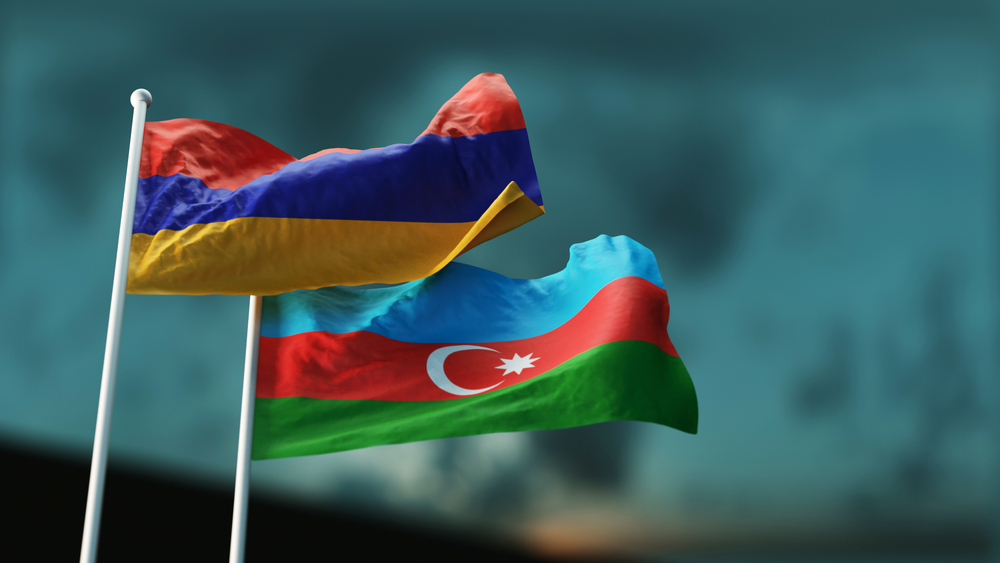
© Vladimir Zotov/Shutterstock
Following a landmark decision by Yerevan and Baku to delimit part of the Armenia-Azerbaijan border, efforts towards an agreement to normalise relations move forward despite anti-Pashinyan protests in Yerevan
Last week, Armenia and Azerbaijan announced that the delimitation process on one part of their shared border had been completed. The news was widely welcomed by the international community as an important step in moving towards an agreement to normalise relations between the two countries after over three decades of enmity. The Armenian opposition, however, continues to protest the move as “illegal” and “unconstitutional”.
According to the Armenian government, however, the border process was conducted without ceding any de jure territory and is based on the 1991 Alma-Ata (Almaty) declaration that marked the dissolution of the former Soviet Union and founded the Commonwealth of Independent States (CIS). In October 2022 in Prague, the Armenian and Azerbaijani leaders agreed to use the treaty as the basis for the mutual recognition and delimitation of each other’s territory.
The European Union welcomed the progress and the resulting protocol, encouraging both sides to take “further decisive steps to tackle other outstanding bilateral issues”, and remains “committed to supporting the efforts aimed at bringing sustainable and lasting peace to the South Caucasus region”.
In a cabinet meeting on 16 May, Pashinyan called the border agreement a “great success” and argued that it would serve as a model for delimiting and demarcating other parts of the border in the future. "An important cornerstone has been laid for the further development and strengthening of our sovereignty and independence”, he said. "For the first time since independence, our republic has an officially delimited border".
Some residents in the section of the border in question are not so enthusiastic. Some property and part of a road will pass to Azerbaijani control, but the government says it will address these issues based on 1976 Soviet military maps that remain valid in the context of Alma-Ata.
Nonetheless, the leader of the protest movement, Archbishop Bagrat Galstanyan, continues to work with the opposition Armenian Revolutionary Federation – Dashnaktsutyun (ARF-D) and Republican Party of former presidents Robert Kocharyan and Serzh Sargsyan to impeach Pashinyan in parliament. At the weekend, he also met with the leaders of other extra-parliamentary opposition parties to gain their support ahead of a 26 May rally to be held in Republic Square.
Several leaders as well as other former officials still promote Galstanyan’s nomination for prime minister if Pashinyan was deposed, even though he is ineligible for the position as he acquired Canadian citizenship when he was Primate of the Diocese of the Armenian Apostolic Church in Canada. Even if he were to renounce, it he would still not fulfill the 4-year requirement of holding only Armenian citizenship before taking office.
Though major rallies are suspended until 26 May, on 15 May Galstanyan did assemble several hundred supporters of his Tavush for the Homeland movement at four separate points around Yerevan’s Liberty Square, where Pashinyan was due to speak at the annual meeting of the European Bank for Reconstruction and Development (EBRD). Key roads were blocked by protesters, who however kept away from the Opera building where the conference took place.
They claimed that the heavy police presence was evidence that the prime minister he is “living in fear” and is unable to control the country, also accusing him of treason. Their focus swiftly moved from attempting to stop the border process to enacting regime change.
Unfazed, Pashinyan addressed delegates with an optimistic speech about the processes underway in the country, including normalisation. "The demarcation process between Armenia and Azerbaijan has started these days and should become one of the tools that will teach Armenia and Azerbaijan to live peacefully”, he said. As part of the agreement, military forces will be withdrawn and replaced by border guards as each section is finalised. That process is already underway.
Yet, in a recent survey held this month, Pashinyan’s rating has dropped to only 12.8%. As usual, that was still higher than the ratings for former president Robert Kocharyan, although Archbishop Galstanyan, included for the first time, came in second with 3.9%. Nonetheless, a large number of Armenians remain undecided or unwilling to vote at all.
With Galstanyan preparing for his next mass rally on 26 May, the coming week will likely determine whether the opposition as a united force can reinvigorate the otherwise waning movement. Further support from the international community might also be enough to prevent Pashinyan’s forced resignation or impeachment. Only 9.3% of respondents supported attempts for a vote of no confidence, while 30% believed he should simply resign.
As for Galstanyan, despite the support for his candidacy from several opposition forces, only 6.7% supported his becoming prime minister in a transitional government were one to be formed. Some 81.5% were undecided or against any of the main opposition front-runners.


































 To Top
To Top